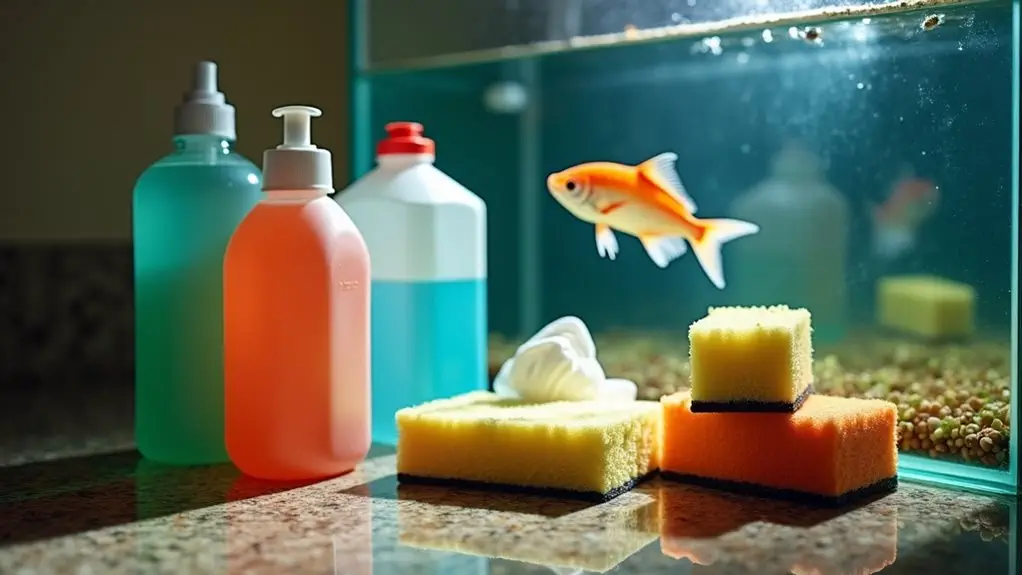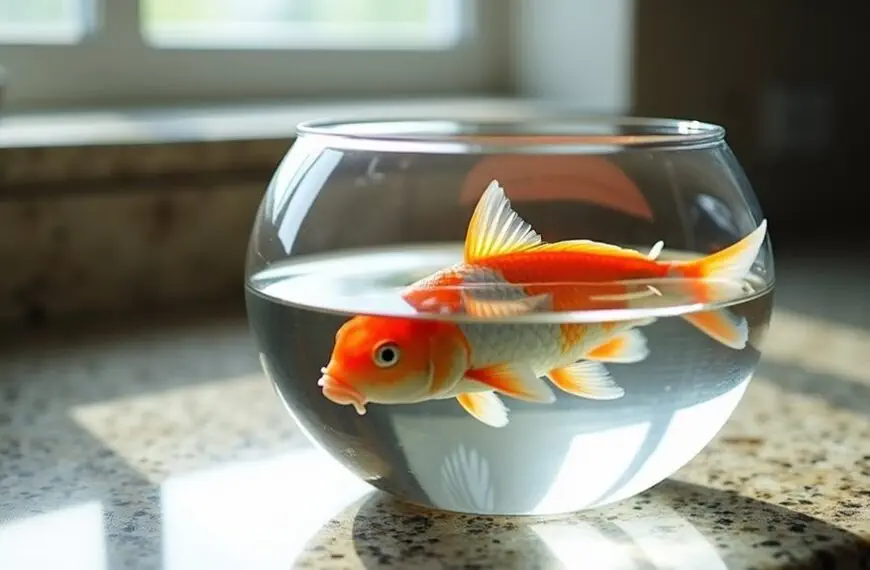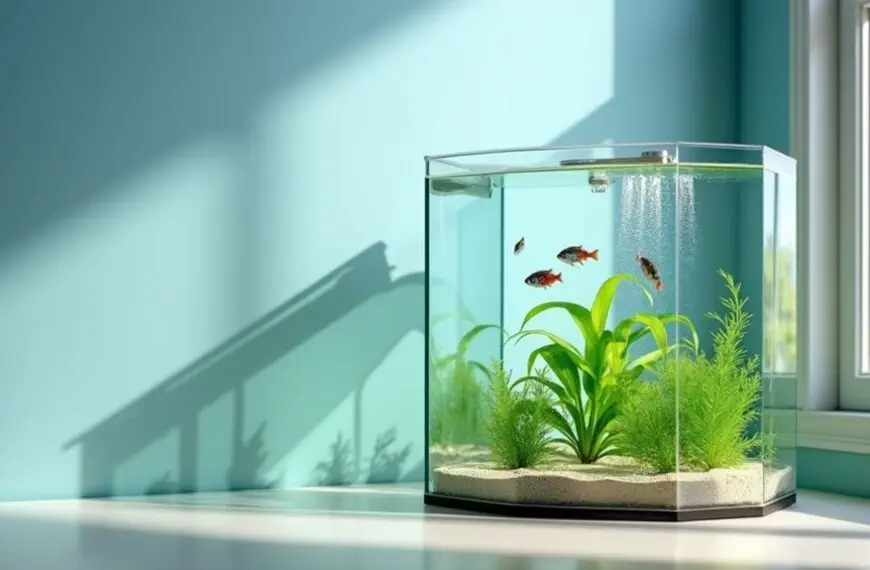You should never clean your fish tank with common household cleaners like bleach, window sprays, or soaps – they'll leave toxic residues that can harm or kill your fish. Don't use tap water without treating it first, since chlorine and ammonia can damage your fish's gills and immune system. Avoid using regular scrubbers or sponges from your kitchen, as they might harbor harmful chemicals or bacteria. Instead, stick to aquarium-specific cleaning products and tools designed for your tank's material, whether it's glass or acrylic. Your underwater friends' health depends on making smart cleaning choices, and there's plenty more to reflect upon when maintaining their home.
Contents
- 1 Dangerous Household Cleaning Products
- 2 Unsafe Water Sources
- 3 Wrong Tools and Equipment
- 4 Poor Tank Maintenance Methods
- 5 Fish Health During Cleaning
- 6 Essential Safety Measures
- 7 Frequently Asked Questions
- 7.1 Can I Use Baby Wipes to Clean the Outside of My Aquarium?
- 7.2 Will Antibacterial Hand Soap Harm Fish if I Wash My Hands First?
- 7.3 Is It Safe to Use Distilled Water for Partial Water Changes?
- 7.4 Can I Use Paper Towels to Wipe the Inside Glass Walls?
- 7.5 Does Using Magnetic Algae Cleaners Scratch Acrylic Aquarium Surfaces?
- 8 Final Thoughts
Dangerous Household Cleaning Products
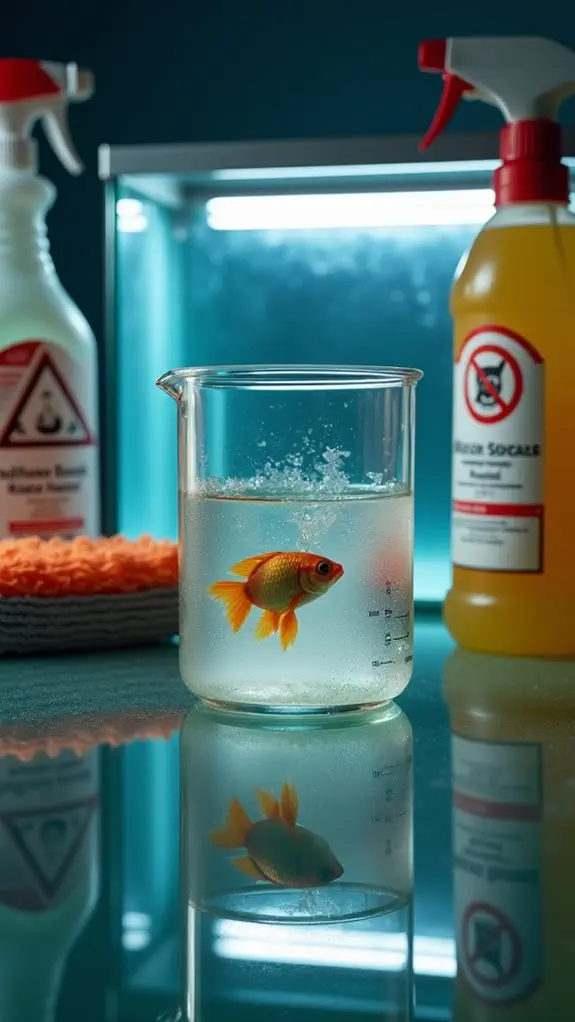
Many household cleaning products contain harmful chemicals that can be lethal to your aquarium fish, even in small amounts. Common cleaners like bleach, window sprays, and antibacterial products leave toxic residues that can poison your fish and disrupt their delicate ecosystem. Regular monitoring of water parameters is vital to ensure that even minor contaminations do not escalate into something dangerous, as excessive toxins can lead to fish stress and illness.
While you might love the fresh scent of synthetic fragrances in your cleaning supplies, these chemicals contain endocrine-disrupting compounds that can seriously harm your finned friends. These fragrances can lead to food chain disruption as toxins accumulate in fish tissues over time. Instead, use designated cleaning equipment that's exclusively meant for aquarium maintenance.
You'll want to steer clear of quaternary ammonium compounds (quats), which are especially dangerous for aquarium use. These stubborn chemicals stick around long after cleaning and can cause devastating effects on your fish. Monitoring ammonia levels in your aquarium is essential, as these chemicals can contribute to elevated toxicity risks.
Also, watch out for products containing 2-butoxyethanol, ammonia, or sodium hypochlorite – they're not just harmful to your fish, but they can affect your health too. Even if you're cleaning near the tank with the lid on, chemicals can still find their way into the water through the air pump.
Unsafe Water Sources
You'll want to be extra careful with your water sources when cleaning your fish tank, as untreated tap water contains harmful chlorine and chloramines that can seriously harm your finned friends. Additionally, using untreated tap water can result in high ammonia levels, which are toxic to fish. While you might think reverse osmosis water is a safe alternative, it actually strips out essential minerals that your fish need to thrive. If you're using tap water, you'll need to treat it with a proper water conditioner, and if you're using RO water, you'll need to add minerals back in with a re-mineralizing product to keep your aquatic pets happy and healthy. Using a dedicated new bucket for your aquarium water changes helps prevent contamination from household cleaning chemicals that could be toxic to fish. Before adding new water to your tank, always match the temperature to avoid stressing your fish with sudden temperature changes.
Untreated Tap Water Dangers
A common mistake fish owners make is using untreated tap water in their aquariums. While it might seem safe enough for us to drink, tap water contains chemical contaminants that can seriously harm your aquatic friends. You wouldn't want your fish swimming in a toxic soup of chlorine, heavy metals, and agricultural runoff, would you? Different species like goldfish and bettas are especially vulnerable to these chemicals.
When you use untreated tap water, you're exposing your fish to harmful substances that can damage their gills, compromise their immune systems, and even lead to death. The use of untreated tap water often results in excess mineral buildup that disrupts your fish's natural osmotic balance. Additionally, these contaminants can lead to stress behaviors that negatively impact fish health and longevity.
If you've noticed your fish gasping at the surface, acting lethargic, or developing mysterious skin problems, your tap water might be the culprit. These issues aren't just temporary – they can cause long-term health problems that'll affect your fish's growth and lifespan.
Don't worry, though – you've got several options to make tap water safe. You can use water conditioners, which quickly neutralize harmful chemicals, or invest in a reverse osmosis system for the cleanest possible water.
Whatever method you choose, just remember: treating your tap water isn't optional – it's essential for keeping your finned friends healthy and happy.
Reverse Osmosis Water Issues
Despite its excellent purification benefits, reverse osmosis (RO) water requires careful handling to prevent contamination from unsafe sources. If you're using RO water in your aquarium, you'll need to be extra vigilant about storage and maintenance to maintain ideal water quality. Similar to distilled water, RO water lacks essential minerals that are vital for aquatic life. Maintaining proper water parameters is crucial as nitrate levels above 100ppm can severely stress your aquatic life. Additionally, consistently testing your RO water can help identify any fluctuations in key parameters that could affect your fish.
Don't store your RO water in dirty containers or leave them uncovered, as this can introduce harmful bacteria and pollutants back into your pristinely filtered water.
You'll want to avoid common mistakes that can compromise your RO system's effectiveness. Don't skip regular membrane maintenance or forget to test your water with a TDS meter – these oversights can lead to poor filtration and potentially harmful water conditions for your fish.
Remember, RO water isn't ready to use straight from the system; it needs proper remineralization and aeration first. Without these vital steps, you're fundamentally putting your fish in stripped-down water that lacks essential minerals and oxygen.
Watch out for temperature fluctuations and pressure issues in your RO system, as these can damage the membrane and reduce filtration efficiency.
Always use clean, dedicated equipment for your RO water handling to maintain its purity.
Wrong Tools and Equipment
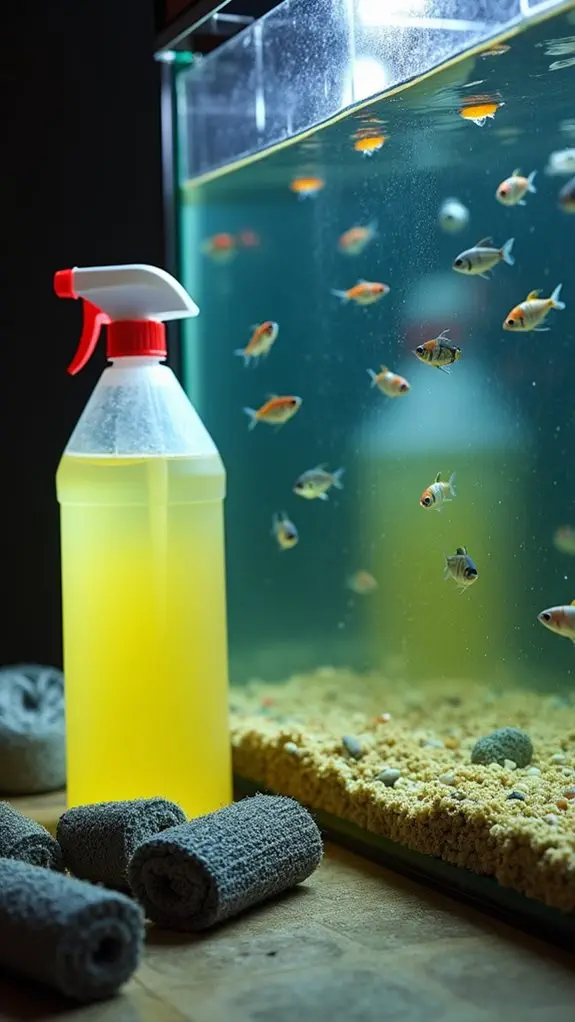
Several common mistakes in fish tank maintenance revolve around using the wrong tools and equipment, which can harm both your aquarium and its inhabitants.
You'll need to pay special attention to equipment sanitation and cross contamination risks, as using the same tools between tanks without proper cleaning can spread diseases faster than office gossip! Using colored hoses or tools can help prevent accidental equipment mixing between tanks.
When it comes to cleaning agents, you'll want to avoid household detergents, bleach, and strong disinfectants – they're great for your kitchen but terrible for your fish! Keep a dedicated bucket specifically for aquarium maintenance to avoid contamination from other household cleaning tasks.
Even tap water can be problematic if it's not properly dechlorinated. If you're thinking about using plain white vinegar, proceed with caution since it can throw off your tank's pH balance.
Don't forget about your scrubbing tools, either. Using glass scrubbers on acrylic tanks is like using sandpaper on your smartphone screen – it'll leave lasting damage.
You'll need specific tools designed for aquarium use to avoid scratches and chemical contamination.
Remember to keep separate equipment for each tank, just like you wouldn't use the same toothbrush for everyone in your household!
Poor Tank Maintenance Methods
Proper tools are just the beginning – your tank maintenance methods can make or break your aquarium's health. When it comes to cleaning, you'll want to avoid common mistakes that can lead to poor water quality and stress out your fishy friends.
Don't rush into replacing large amounts of water – removing more than 50% at once can shock your aquatic pets. Always treat new water with a dechlorinator, and make sure it matches your tank's temperature and pH levels.
You're not doing your fish any favors by using tap water to clean filter media, as this kills beneficial bacteria that keep your tank healthy.
Speaking of inadequate filtration, timing is everything. Don't clean your filter right after a major tank cleaning – wait a couple of weeks to maintain those vital bacterial colonies.
When you do clean filter media, be gentle and use tank water to preserve the good bacteria. Regular testing helps ensure optimal water parameters for a stable environment that supports fish health. Remember to replace chemical media like carbon and ammonia absorbers every three weeks, but don't go overboard with cleaning mechanical media like sponges and ceramic rings – sometimes less really is more!
Fish Health During Cleaning
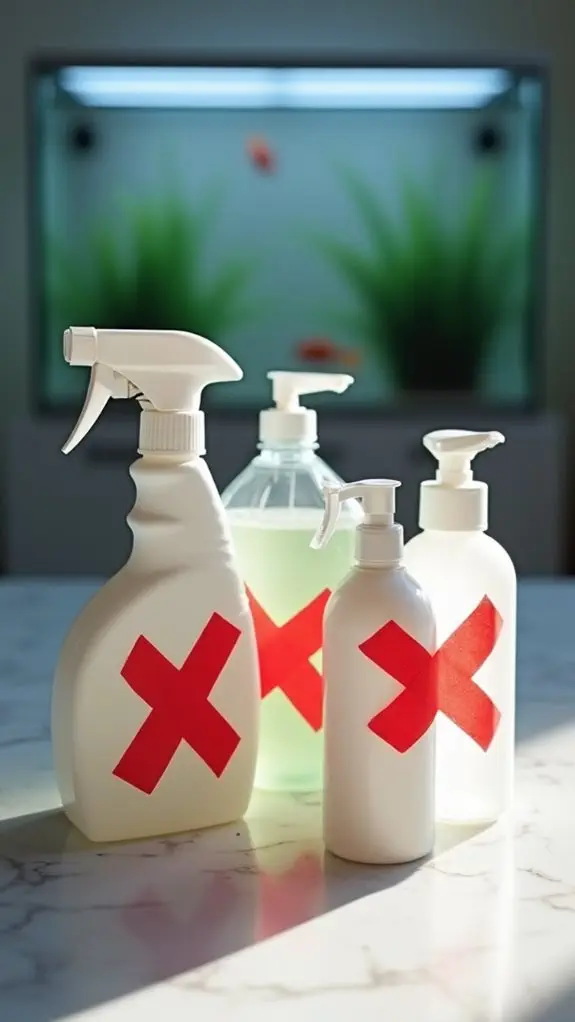
Maintaining your fish's well-being during tank cleaning requires careful attention to their stress levels and environmental needs. Your finned friends can become quite anxious during cleaning time, and it's vital to minimize their distress while keeping their home sparkling clean.
To protect your fish during cleaning, you'll want to make gradual changes rather than dramatic ones. Think of it like slowly dipping your toe into a pool rather than jumping in – fish prefer the gentle approach! When adjusting water chemistry, make small, incremental changes that won't shock their systems.
Keep an eye on your fish's behavior during the cleaning process, as they'll let you know if something's not right through signs like rapid gill movement or erratic swimming.
After cleaning, don't forget to monitor the water parameters and guarantee proper circulation. Your fish need time to adjust to their refreshed environment, so watch them closely for the next few hours. Proper testing for ammonia levels is essential to prevent any immediate stress following the cleaning.
Regular maintenance schedules help prevent major issues, and keeping consistent water conditions will make cleaning day much less stressful for everyone involved. Remember, a happy fish is one that doesn't feel like its world is being turned upside down during cleaning time!
Essential Safety Measures
Now that you understand how to protect your fish during cleaning, let's focus on keeping yourself and your pets safe throughout the process.
Taking proper cleaning precautions isn't just about protecting your aquatic friends – it's about guaranteeing everyone's safety, including yours!
When it comes to chemical safety, you'll want to avoid common household cleaners that can harm both you and your fish. Instead, stick to aquarium-specific products and create a dedicated cleaning space away from curious pets and children.
Here are essential safety measures you shouldn't skip:
- Always unplug electrical equipment before starting any cleaning tasks – water and electricity don't mix!
- Use separate cleaning tools for your aquarium to prevent cross-contamination from other household cleaning supplies.
- Keep pets and children away from the cleaning area to avoid accidents with tank water.
- Wear appropriate protection and wash your hands thoroughly before and after maintenance. Implementing proper water quality management is crucial for both the health of your fish and your own safety during cleaning.
Remember to maintain proper control of your siphon during water changes, and guarantee any replacement water matches your tank's temperature.
If you're ever unsure about a cleaning product or method, it's better to err on the side of caution and consult with an aquarium professional.
Frequently Asked Questions
Can I Use Baby Wipes to Clean the Outside of My Aquarium?
You shouldn't use baby wipes for aquarium maintenance, as they contain quaternary ammonium compounds that can harm fish even when cleaning the outside. Instead, use plain soap and water or aquarium-safe cleaners.
Will Antibacterial Hand Soap Harm Fish if I Wash My Hands First?
Yes, antibacterial soap will harm your fish, even after washing. The chemicals, especially triclosan, remain on your hands and can leach into the tank water. Use plain water or fish-safe hand cleaners instead.
Is It Safe to Use Distilled Water for Partial Water Changes?
You shouldn't use pure distilled water for partial changes as it lacks essential minerals. Instead, you'll need to remineralize it first or mix it with tap water to maintain proper mineral levels for your fish.
Can I Use Paper Towels to Wipe the Inside Glass Walls?
Don't use paper towels for your fish tank maintenance inside the glass. They'll leave behind harmful fibers and chemicals. Instead, use proper cleaning supplies like algae scrapers or aquarium-safe pads for best results.
Does Using Magnetic Algae Cleaners Scratch Acrylic Aquarium Surfaces?
You'll need to use magnetic cleaners specifically designed for acrylic care to avoid scratches. For safe algae removal, guarantee your cleaner has soft, non-abrasive pads and don't apply too much pressure while cleaning.
Final Thoughts
Remember, your fish's home is a delicate ecosystem that deserves proper care and attention. You'll want to avoid harsh chemicals, untreated tap water, and abrasive tools that could harm your aquatic friends. Instead, stick to aquarium-specific products and gentle cleaning methods. By following safe cleaning practices and maintaining regular care schedules, you're giving your fish the best chance at a happy, healthy life in their crystal-clear home.

